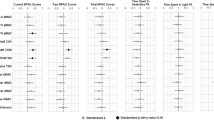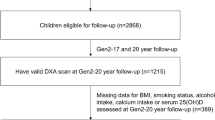Abstract
Summary
A newly developed bone-specific physical activity questionnaire (BPAQ) was compared with other common measures of physical activity for its ability to predict parameters of bone strength in healthy, young adults. The BPAQ predicted indices of bone strength at clinically relevant sites in both men and women, while other measures did not.
Introduction
Only certain types of physical activity (PA) are notably osteogenic. Most methods to quantify levels of PA fail to account for bone relevant loading. Our aim was to examine the ability of several methods of PA assessment and a new bone-specific measure to predict parameters of bone strength in healthy adults.
Methods
We recruited 40 men and women (mean age 24.5). Subjects completed the modifiable activity questionnaire, Bouchard 3-day activity record, a recently published bone loading history questionnaire (BLHQ), and wore a pedometer for 14 days. We also administered our bone-specific physical activity questionnaire (BPAQ). Calcaneal broadband ultrasound attenuation (BUA) (QUS-2, Quidel) and densitometric measures (XR-36, Norland) were examined. Multiple regression and correlation analyses were performed on the data.
Results
The current activity component of BPAQ was a significant predictor of variance in femoral neck bone mineral density (BMD), lumbar spine BMD, and whole body BMD (R2 = 0.36–0.68, p < 0.01) for men, while the past activity component of BPAQ predicted calcaneal BUA (R2 = 0.48, p = 0.001) for women.
Conclusions
The BPAQ predicted indices of bone strength at skeletal sites at risk of osteoporotic fracture while other PA measurement tools did not.

Similar content being viewed by others
References
Rubin CT (1984) Skeletal strain and the functional significance of bone architecture. Calcif Tissue Int 36(Suppl 1):S11–18
Rubin CT, Lanyon LE (1985) Regulation of bone mass by mechanical strain magnitude. Calcif Tissue Int 37:411–417
O’Connor JA, Lanyon LE, MacFie H (1982) The influence of strain rate on adaptive bone remodelling. J Biomech 15:767–781
Turner CH, Owan I, Takano Y (1995) Mechanotransduction in bone: Role of strain rate. Am J Physiol 269:E438–442
Kannus P, Haapasalo H, Sankelo M et al (1995) Effect of starting age of physical activity on bone mass in the dominant arm of tennis and squash players. Ann Intern Med 123:27–31
Burr DB, Milgrom C, Fyhrie D et al (1996) In vivo measurement of human tibial strains during vigorous activity. Bone 18:405–410
Ekenman I, Halvorsen K, Westblad P et al (1998) Local bone deformation at two predominant sites for stress fractures of the tibia: An in vivo study. Foot Ankle Int 19:479–484
Lanyon LE, Hampson WG, Goodship AE et al (1975) Bone deformation recorded in vivo from strain gauges attached to the human tibial shaft. Acta Orthop Scand 46:256–268
Milgrom C, Miligram M, Simkin A et al (2001) A home exercise program for tibial bone strengthening based on in vivo strain measurements. Am J Phys Med Rehabil 80:433–438
Milgrom C, Radeva-Petrova DR, Finestone A et al (2007) The effect of muscle fatigue on in vivo tibial strains. J Biomech 40:845–850
Milgrom C, Finestone A, Levi Y et al (2000) Do high impact exercises produce higher tibial strains than running? Br J Sports Med 34:195–199
Hurrion PD, Dyson R, Hale T (2000) Simultaneous measurement of back and front foot ground reaction forces during the same delivery stride of the fast-medium bowler. J Sports Sci 18:993–997
Perttunen JO, Kyrolainen H, Komi PV et al (2000) Biomechanical loading in the triple jump. J Sports Sci 18:363–370
Salci Y, Kentel BB, Heycan C et al (2004) Comparison of landing maneuvers between male and female college volleyball players. Clin Biomech 19:622–628
Dolan SH, Williams DP, Ainsworth BE et al (2006) Development and reproducibility of the bone loading history questionnaire. Med Sci Sports Exerc 38:1121–1131
Turner CH, Robling AG (2003) Designing exercise regimens to increase bone strength. Exerc Sport Sci Rev 31:45–50
Turner CH, Robling AG (2005) Exercises for improving bone strength. Br J Sports Med 39:188–189
Snow CM, Williams DP, LaRiviere J et al (2001) Bone gains and losses follow seasonal training and detraining in gymnasts. Calcif Tissue Int 69:7–12
Kriska AM, Bennett PH (1992) An epidemiological perspective of the relationship between physical activity and NIDDM: from activity assessment to intervention. Diabetes Metab Rev 8:355–372
Bouchard C, Tremblay A, Leblanc C et al (1983) A method to assess energy expenditure in children and adults. Am J Clin Nutr 37:461–467
Pluijm SM, Graafmans WC, Bouter LM et al. (1999) Ultrasound measurements for the prediction of osteoporotic fractures in elderly people. 9:550–556
Prins SH, Jorgensen HL, Jorgensen LV et al. (1998) The role of quantitative ultrasound in the assessment of bone: a review. 18:3–17
Wuster C, Hadji P (2001) Use of quantitative ultrasound densitometry (QUS) in male osteoporosis. 69:225–228
Sievanen H, Kannus P, Nieminen V et al (1996) Estimation of various mechanical characteristics of human bones using dual energy x-ray absorptiometry: Methodology and precision. Bone 18:17S–27S
Peterman MM, Hamel AJ, Cavanagh PR et al (2001) In vitro modeling of human tibial strains during exercise in micro-gravity. J Biomech 34:693–698
McKay H, Tsang G, Heinonen A et al (2005) Ground reaction forces associated with an effective elementary school based jumping intervention. Br J Sports Med 39:10–14
Hert J, Liskova M, Landa J (1971) Reaction of bone to mechanical stimuli. Part 1. Continuous and intermittent loading of tibia in rabbit. Folia Morphol 19:290–300
Umemura Y, Ishiko T, Yamauchi T et al (1997) Five jumps per day increase bone mass and breaking force in rats. J Bone Miner Res 12:1480–1485
Robling AG, Burr DB, Turner CH (2001) Recovery periods restore mechanosensitivity to dynamically loaded bone. J Exp Biol 204:3389–3399
Robling AG, Hinant FM, Burr DB et al (2002) Shorter, more frequent mechanical loading sessions enhance bone mass. Med Sci Sports Exerc 34:196–202
Robling AG, Hinant FM, Burr DB et al (2002) Improved bone structure and strength after long-term mechanical loading is greatest if loading is separated into short bouts. J Bone Miner Res 17:1545–1554
Frederick EC, Determan JJ, Whittlesey SN et al (2006) Biomechanics of skateboarding: Kinetics of the Ollie. J Appl Biomech 22:33–40
Kellis E, Katis A, Vrabas IS (2006) Effects of an intermittent exercise fatigue protocol on biomechanics of soccer kick performance. Scand J Med Sci Sports 16:334–344
Otago L (2004) Kinetic analysis of landings in netball: is a footwork rule change required to decrease ACL injuries? J Sci Med Sport 7:85–95
Taaffe DR, Snow Harter C, Connolly DA et al (1995) Differential effects of swimming versus weight-bearing activity on bone mineral status of eumenorrheic athletes. J Bone Miner Res 10:586–593
Bass S, Delmas PD, Pearce G et al (1999) The differing tempo of growth in bone size, mass, and density in girls is region-specific. J Clin Invest 104:795–804
Bradney M, Karlsson MK, Duan Y et al (2000) Heterogeneity in the growth of the axial and appendicular skeleton in boys: Implications for the pathogenesis of bone fragility in men. J Bone Miner Res 15:1871–1878
Acknowledgements
The authors would like to acknowledge the assistance of Dr Rod Barrett and Dr Justin Kavanagh in the data collection phase of the project. There were no external funding sources for this project.
Conflict of interest
None.
Author information
Authors and Affiliations
Corresponding author
Appendices
Appendix A


Appendix B
Algorithms used to analyse BPAQ responses
Current BPAQ (cBPAQ) algorithm:
cBPAQ = [R + 0.2R(n-1)] x a
R = effective load stimulus (derived from GRF testing)
n = frequency of participation (per week)
a = age weighting factor
(age weightings: <10 yrs = 1.2; 10–15 yrs = 1.5; 15–35 yrs = 1.1; >35 yrs = 1.0)
Past BPAQ (pBPAQ) algorithm:
pBPAQ = R x y x a
= effective load stimulus (derived from GRF testing)
y = years of participation
a = age weighting factor
(age weightings: <15 yrs = 0.25; >15 yrs 0.10)
Appendix C
Table 6
Rights and permissions
About this article
Cite this article
Weeks, B.K., Beck, B.R. The BPAQ: a bone-specific physical activity assessment instrument. Osteoporos Int 19, 1567–1577 (2008). https://doi.org/10.1007/s00198-008-0606-2
Received:
Accepted:
Published:
Issue Date:
DOI: https://doi.org/10.1007/s00198-008-0606-2




